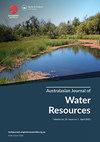Water systems and disruptions: the ‘old abnormal’?
IF 2.2
Q2 WATER RESOURCES
引用次数: 7
Abstract
ABSTRACT The dual nature of water – giver of life and massive disruptor – is not new. There is rarely one equilibrium state for a water system; there are multiple different states natural water systems cycle through. And human-induced changes to water systems, including through the use of technologies to modify and exploit them, and through climate change, further accentuate the opportunities for extreme disruptions to society. Human history is dotted with examples of challenges in managing water systems and disruptions. This year, parts of Australasia have seen widespread drought, massive fires, smoke pollution, ecological destruction, hail storms, cyclones and now a pandemic, COVID-19, protection from which requires adequate safe water and space for hygiene and limiting transmission. Our notions of time, space and connection to others and our environment, including water, have again come into focus as we search for a new equilibrium after this wave of disruptions – a ‘new normal’. But is this just a very human desire for stability amid the seeming chaos? Instead, do we instead need to get better at managing more appropriately through the ‘old abnormal’: the continuous variability, change and increasingly extreme events due in part to human modification and societal expansion across the planet? This editorial paper provides a reflection on the moment we have found ourselves in at the beginning of 2020. It draws together insights from a range of water science and management challenges presented in the papers of this issue, in order to chart some positive ways for more appropriately navigating water systems and their future disruptions.供水系统和中断:“旧的异常”?
摘要水的双重性质——生命的给予者和巨大的破坏者——并不是什么新鲜事。水系统很少有一种平衡状态;自然水系统有多种不同的循环状态。人类对水系统的改变,包括通过使用技术来改造和利用水系统,以及通过气候变化,进一步加剧了对社会造成极端破坏的机会。人类历史上有许多例子表明,在管理供水系统和供水中断方面存在挑战。今年,澳大拉西亚部分地区出现了大范围干旱、大规模火灾、烟雾污染、生态破坏、冰雹风暴、旋风,现在又出现了一场大流行新冠肺炎,需要足够的安全用水和卫生空间来保护和限制传播。我们对时间、空间以及与他人和环境(包括水)的联系的概念再次成为焦点,因为在这一波破坏之后,我们正在寻找一种新的平衡——一种“新常态”。但这只是人类在看似混乱的情况下对稳定的渴望吗?相反,我们是否需要更好地管理“旧的异常”:持续的变异、变化和越来越极端的事件,部分原因是人类的改造和全球社会的扩张?这篇社论对我们在2020年初所处的时刻进行了反思。它汇集了本期论文中提出的一系列水科学和管理挑战的见解,以制定一些积极的方法,更恰当地引导水系统及其未来的破坏。
本文章由计算机程序翻译,如有差异,请以英文原文为准。
求助全文
约1分钟内获得全文
求助全文
来源期刊

Australasian Journal of Water Resources
WATER RESOURCES-
CiteScore
5.10
自引率
21.90%
发文量
25
期刊介绍:
The Australasian Journal of Water Resources ( AJWR) is a multi-disciplinary regional journal dedicated to scholarship, professional practice and discussion on water resources planning, management and policy. Its primary geographic focus is on Australia, New Zealand and the Pacific Islands. Papers from outside this region will also be welcomed if they contribute to an understanding of water resources issues in the region. Such contributions could be due to innovations applicable to the Australasian water community, or where clear linkages between studies in other parts of the world are linked to important issues or water planning, management, development and policy challenges in Australasia. These could include papers on global issues where Australasian impacts are clearly identified.
 求助内容:
求助内容: 应助结果提醒方式:
应助结果提醒方式:


